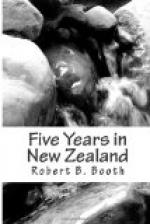On reaching the river it was so swollen as to be unsafe to attempt fording, and so, lighting my pipe, I sat down under the shelter of a large boulder, and presently fell asleep. When I woke up, after some considerable time, and remembered where I was, I feared that Cook and Butler must have passed while I slept, and was on the point of returning to the station, when I observed two horsemen a long way down stream, apparently searching for something. I speedily understood what was on foot. My friends were laboriously seeking for my dead body, having naturally supposed, when they could not find me at the paddock, that I had tried to ford the river and been washed away. The idea of these two men spending the morning hunting for a supposed drowned man, who was enjoying a sound sleep near them all the time, was so ludicrous that I could not refrain from an immoderate fit of laughter when they arrived.
Butler was hot-tempered, and anything approaching to ridicule where he himself was concerned was a mortal insult. He turned pale with passion and rode off, and I do not think he ever entirely forgave me for not being drowned when he had undertaken so much trouble to discover my body.
It was at Mesopotamia that I noticed so many remains of that extinct bird, the “Moa,” and it appeared that some of the species had inhabited that locality not very many years previously. Indeed, some old Maoris I had met on the Ashburton said they remembered the bird very well. It was not uncommon to come across a quantity of bones, and near by them a heap of smooth pebbles which the bird had carried in his craw for digestive purposes, and I recollect one day employing a number of the bones in making a footway over a small creek.
A complete skeleton of the Moa bird is to be seen in the British Museum.
I had now obtained a fresh contract for making cuttings, draining swamps, and bridging over some ten miles in the Lower Ashburton gorge and Valley, and I was busily engaged all the summer and autumn. There were some extensive patches of swampy ground where great difficulty was experienced in passing the heavy wool drays, and to make a feasible road over them was one of my tasks, and an interesting one it proved, giving some scope to my engineering ability. Having laid out the proposed line of road over the marsh, I cut from it at right angles, and some 300 feet in length, a channel wide and deep enough, I calculated, to convey away the flood water during heavy rains, and from the upper end of this channel I cut four feeding drains, two running along the road line, and two diagonally, all four meeting at the top end of the main channel; over the latter, at this point, I constructed a wooden bridge of rough green timber from the forest, distant about eight miles. I sunk a row of heavy round piles or posts about a foot in diameter at each side of the channel, which was fifteen feet wide, securing them with heavy transverse




